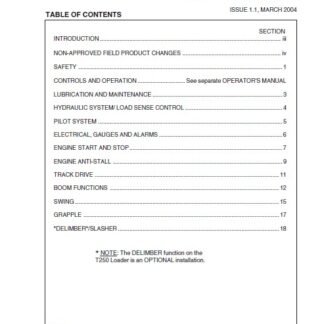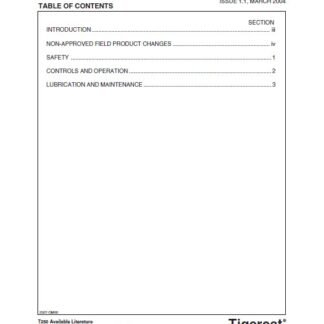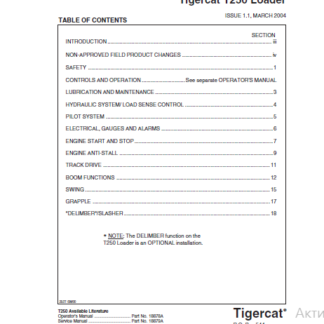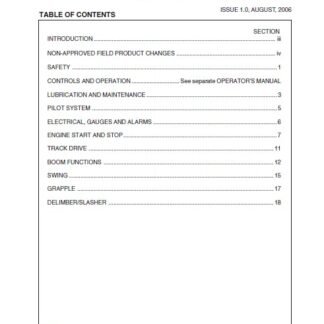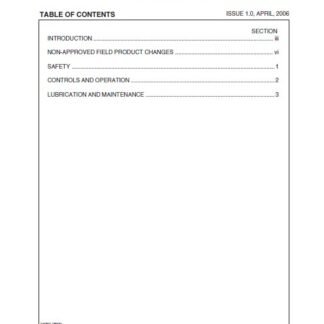
How to Use a Tigercat Manual to Make Repairs Right Now
Tigercat equipment is renowned for its durability and performance in the forestry sector. However, like any machinery, regular maintenance and occasional repairs are essential to ensure optimal operation. Whether you’re an experienced technician or a first-time user, leveraging a Tigercat manual can make the repair process more efficient and effective. In this article, we’ll guide you through understanding the manual’s structure, identifying key sections for quick repairs, gathering necessary tools and materials, and providing step-by-step repair guidance and tips. For further reference, you can visit Tigercat Manual.
Understanding Your Tigercat Manual’s Structure
The first step to successfully using a Tigercat manual is understanding its structure. The manual is typically organized into several sections, each serving a distinct purpose. Initially, you’ll find the table of contents, which provides an overview of the entire document, allowing you to quickly locate specific topics or components that need attention. Following this, you will encounter an introduction to the equipment, which includes safety instructions, specifications, and general operational guidelines.
Next, the manual is divided into chapters that delve into different systems and components of the Tigercat machine. These chapters often include detailed diagrams, illustrations, and schematics that are crucial for visualizing the internal workings of the equipment. Such illustrations are invaluable, especially when dealing with complex machinery, as they provide a clear reference for identifying parts and understanding their interconnections.
Furthermore, the manual includes a troubleshooting section that is essential for diagnosing issues. This section typically lists common problems, symptoms, and potential causes, offering a logical starting point for repairs. By following the structured approach outlined in the manual, users can systematically address and resolve issues, reducing downtime and preventing further damage.
Finally, an index is usually present at the end of the manual, which aids in quickly finding specific information without having to browse through the entire document. Understanding this structure not only saves time but also ensures that you maximize the manual’s utility during repairs. For more detailed insights, consider exploring Tigercat Manual.
Identifying Key Sections for Quick Repairs
When time is of the essence, knowing which sections of the Tigercat manual to focus on can significantly expedite the repair process. One of the most critical sections for quick repairs is the troubleshooting guide. This part of the manual provides a list of symptoms and corresponding diagnostic steps, enabling you to pinpoint issues swiftly and accurately.
Another vital section is the maintenance chapter, which includes routine service procedures. This section often outlines common repair tasks such as replacing filters, checking fluid levels, and inspecting belts and hoses. By following these procedures, you can address minor issues before they escalate into major problems, thus maintaining the equipment’s performance and longevity.
The parts catalog is another key section that should not be overlooked. It provides detailed information on every component of the machine, including part numbers and descriptions. This information is crucial when ordering replacement parts, ensuring that you receive the correct items for your repairs. Additionally, the parts catalog often includes exploded views of assemblies, aiding in the disassembly and reassembly processes.
Lastly, safety instructions should always be a priority when performing repairs. This section outlines necessary precautions and safety measures to prevent accidents and injuries. By adhering to these guidelines, you can create a safe work environment, which is essential for both quick and effective repairs. For further information and resources, visit Tigercat Manual.
Gathering Necessary Tools and Materials
Before embarking on any repair task, it’s crucial to gather all the necessary tools and materials. The Tigercat manual often lists the required tools for specific repairs in the respective sections, ensuring you have everything you need to complete the job efficiently. Typical tools might include wrenches, screwdrivers, pliers, and specialized equipment such as torque wrenches or diagnostic devices.
In addition to tools, having the right materials and replacement parts is equally important. The manual’s parts catalog is an invaluable resource for identifying part numbers and specifications, which helps in procuring the correct items from suppliers. This preparation minimizes interruptions during the repair process, allowing for a smoother workflow.
It’s also wise to have consumables on hand, such as lubricants, sealants, and cleaning agents, which are often required during maintenance and repair tasks. These materials help in ensuring that components are reassembled correctly and operate smoothly post-repair. The manual may provide recommendations on suitable products to use, which can prolong the equipment’s lifespan.
Lastly, setting up a clean and organized workspace is essential. This not only improves efficiency but also reduces the risk of losing small parts or tools during the repair process. By preparing thoroughly and consulting the manual, you can tackle repairs with confidence and precision. More information on tool and material preparation can be found at Tigercat Manual.
Step-by-Step Repair Guidance and Tips
Executing repairs effectively requires a methodical approach, and the Tigercat manual provides step-by-step guidance to assist you. Begin by carefully reading through the repair section relevant to the issue at hand. Pay close attention to the instructions and diagrams provided, as these will guide you through the disassembly, repair, and reassembly processes.
As you proceed, take note of any special tips or warnings highlighted in the manual. These insights often come from the manufacturer’s expertise and are designed to prevent common mistakes or dangers. For instance, certain components may require specific torque settings or alignment procedures that are critical for the machinery’s proper function.
Another useful practice is to document each step of the repair process. This can be done by taking notes or photographs, which serve as a reference for reassembly and future repairs. Additionally, maintaining a record of repairs can help in tracking the machine’s maintenance history, which is beneficial for long-term upkeep.
Finally, once the repair is complete, it’s important to test the equipment to ensure that the issue has been resolved and that the machine operates as expected. The manual may include post-repair checks or calibration procedures to verify the repair’s success. By following the manual’s guidance and incorporating these tips, you can achieve reliable and effective repairs. For more detailed repair guidance, refer to Tigercat Manual.
In conclusion, utilizing a Tigercat manual for repairs is an invaluable practice that enhances both the efficiency and effectiveness of the maintenance process. By understanding the manual’s structure, identifying key sections for quick reference, gathering the necessary tools and materials, and following step-by-step guidance, you can address issues promptly and competently. Whether you’re dealing with routine maintenance or complex repairs, the manual serves as a comprehensive resource, ensuring your equipment remains in peak condition. For additional support and information, don’t hesitate to visit Tigercat Manual.


